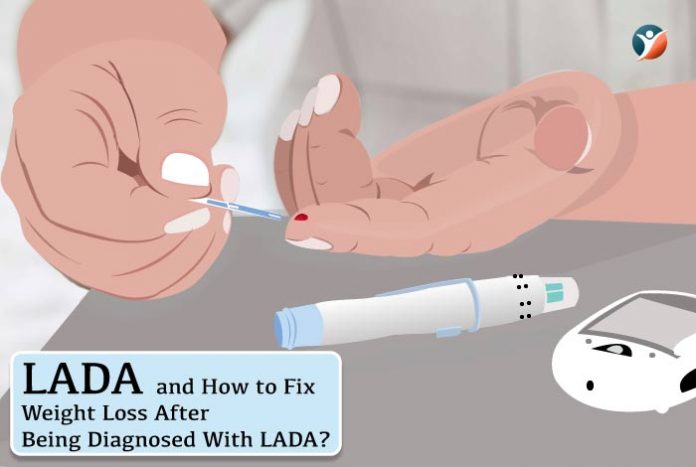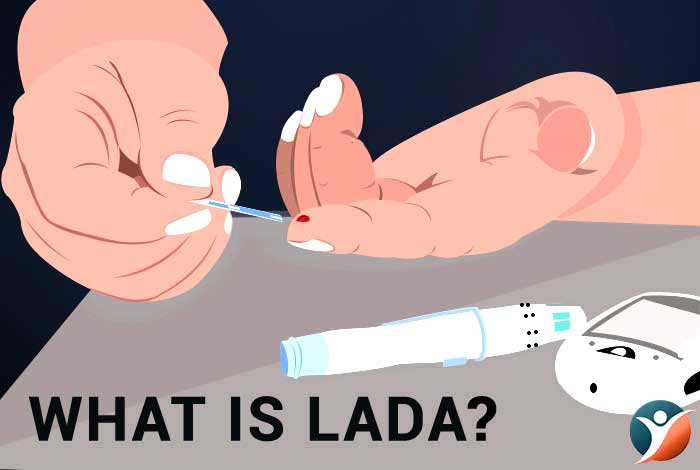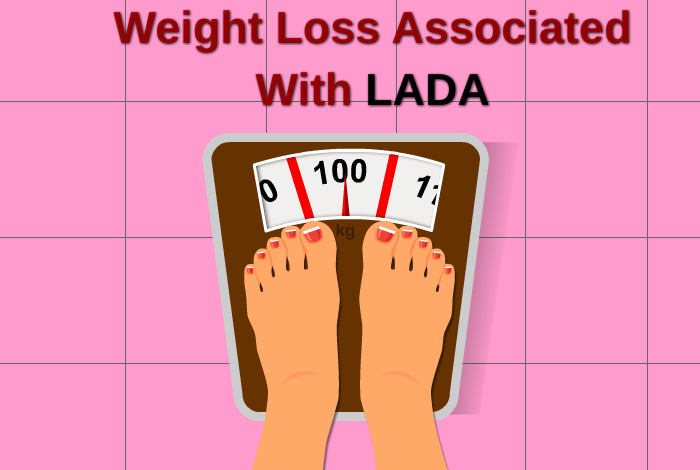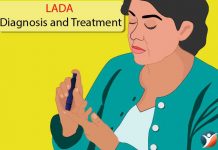
Recently diagnosed with LADA (Latent autoimmune diabetes of adults) and losing weight unintentionally? If your answer is a sad nod, don’t worry we are here to help. People with LADA are generally thin or keep losing weight. Few LADA patients report dropping significant pounds, just over a short time period.
Read on to know why there is weight loss and importantly, how can you prevent this unintentional weight loss. If you have already lost a considerable weight, there is enough you can do to gain that weight back. Let’s delve deeper in this domain.
Table of Contents
- What is LADA?
- Symptoms of LADA
- Weight Loss Associated With LADA
- What You Can Do to Prevent Weight Loss or To Gain Weight After being
- Who is At Risk of LADA?
- Conclusion
What is LADA?

Let’ s take a look into what exactly LADA is.
It is nothing great to know about LADA, if you are already diagnosed with it. We understand your pain and concern. Let’ s take a look into what exactly LADA is. LADA is short for Latent Autoimmune Diabetes of Adulthood. While so much is clear from the name itself, it is a form of diabetes that develops much late into adulthood. Quite unlike type-1 diabetes that develops right into childhood.
However, it tends to develop more gradually than type-1 diabetes. Since LADA is symptomatically similar to type-2 diabetes, it is often misdiagnosed as type-2 diabetes. LADA patients generally don’t require insulin. It is commonly diagnosed in people aged between 30 to 50 years. The sufferers have antibodies to glutamic acid decarboxylase (GAD). A test for GAD antibodies is long used as a diagnostic method of LADA in people over 30 years of age.
Symptoms of LADA

The initial symptoms of LADA are:
- Feeling exhausted or tired all the time, especially after meals.
- Brain Fog
- Feeling hungry soon after you have consumed meals
- Irritability and Mood changes
As LADA gradually develops, the symptoms worsen as the body is not able to produce insulin. These symptoms include:
- Hard to quench thirst
- Need to urinate frequently
- Tingling nerves
- Dry and itchy skin
- High levels of sugar in blood and urine, when they are tested
- Blurred vision
Weight Loss Associated With LADA

If you are diagnosed with type 1.5 diabetes or LADA, you might have lost significant pounds without even trying to lose weight. Well, that is both intimidating and absurd at the same time. Most of the people diagnosed with LADA are generally thin or weigh normal. Now, losing weight poses a serious threat on your health and must be tackled with utter seriousness.
In fact, unintentional or unexplained weight loss can be a symptom of undiagnosed diabetes. Issues with weight usually are centered around insulin. Insulin is a hormone produced by pancreas. Diabetics are unable to either utilize or produce insulin to effectively transport the excess sugar out of the blood, into the body cells. This hampers the utilization of sugar for energy. This might cause your body to burn the existing fat stores and muscle tissues, for the required energy. If your blood sugar levels are constantly in flux, your body will continue burning off its fat stores for required energy.
People report having dropped 20 or more pounds within a span of few months, after being diagnosed with LADA. It is therefore important to keep your weight in normal range. Let’s understand how you can do this.
What You Can Do to Prevent Weight Loss or To Gain Weight After You Are Diagnosed With LADA?

Generally, most of the diabetes diets focus on losing weight, rather than gaining weight. This can especially make it harder to gain weight, in a healthier way. If you are struggling with your appetite or have lost pounds unintentionally, it is crucial to eat foods that you like rather than staying away from them. This might mean eating foods with higher fat content and calories.
Let’s get straight into what you must do to gain weight or prevent unexpected weight loss if you have LADA.
1. Start Using an App:
There are various apps available that can both keep a check on your blood sugar levels and your BMI. These apps can effectively analyze the amount of fats, carbohydrates fiber, calories and fat in each of your meals. You can also track your diet, activity against your fitness goals and nutritional targets. SuperTracker and GlucOracle are some apps for this purpose.
2. Determine What Your Ideal Weight Must Be:
Just like it is crucial to know your current weight, it is also important to know your ideal weight. You can set weekly weight goals, to keep a track on how far you have reached. You must also be aware of your Body Mass Index (BMI), that can help you in figuring out your ideal weight according to your height and body frame. Your doctor can further help you in chalking out your ideal weight, making things a bit easier for you.
3. Gorge on Six Small Meals A Day:
While you might be consuming three large meals a day, you could still be struggling to gain weight. The trick is to eat small meals every three hours, so don’t let your body use your fat stores for energy. It might be difficult to implement this eating pattern at first, but you really need to ensure that all your meals are calorie dense and nutrient rich. You can also plan all your meals for the week. Drink fluids half or an hour before your meals and never between your meal, as to not fill up on fluids. The meals must possibly include:
- Vegetables
- Fresh fruits
- Whole grains
- Polyunsaturated and monosaturated fats
- Lean protein
Let’s see how typical meals of your day must somewhat be like.
Breakfast: Bacon, scrambled eggs and a whole grain toast. You can drizzle few drops of olive oil if you wish.
Snack: Almonds, cheddar cheese and a green apple.
Lunch: Turkey sandwich, avocado salad, topped with a low-calorie dressing and seeds.
Snack: Low-sugar Greek Yogurt with cranberries and walnuts.
Dinner: Grilled salmon along with quinoa. Broccoli with cheese sauce can be taken as a side dish.
Snack: Peanut butter smeared over whole-grain crackers.
Remember, snacks are rather important for you; now that you are
trying to gain weight. More importantly, healthy snacking.
4. Load Up on Healthy Carbs, All Day Long:
Eating carbohydrates that have a low glycemic index helps in keeping the blood sugar levels in control. Incorporating healthy carbs in your six small meals a day plan, you can easily gain weight. Amid all this, it is important to keep a close watch on your sugar levels. A great idea is to add fat or protein to your diet every time you consume carbohydrates. This would ensure that you are consuming enough calories, without letting your sugar level to spike. Below is a list of few healthy carbohydrates:
- Vegetables
- Whole grains
- Nuts
- Berries
- Legumes
- Seeds
- Nuts
5. Go for Healthy Fats:
Yes, it is time to stop worrying about consuming fats. Opt for healthy fats including monosaturated and polyunsaturated fats. Adding healthy fat to each of your meal can help you in gaining weight, without gorging on empty calories. Some healthy fats include:
- Olive oil
- Avocados
- Nuts
- Canola oil
- Seeds
- Fatty fish such as mackerel and salmon
6. Consume Sufficient Dietary Protein:
Protein is extremely important for maintaining the muscle mass. However, it is important to consult your doctor for knowing how much protein you should consume based on your weight goal and kidney function. For instance, if you are currently eating four ounces of protein each day, you might need to kick it up-to six ounces or more each daily. Good protein sources are as follows:
- Chicken
- Beans
- Fish
- Eggs
- Soy
7. Say No to Low-Calorie Beverages and Foods:
For gaining weight, you would need to consume at-least 500 calories more each day. This clearly means you have to let go of low-calorie foods and beverages. What! Can’t give up on lettuce or that crunch of celery? We will tell you how. Try putting celery in your chicken salad. Alternatively, you can fill a stalk with almond butter or cream cheese. Add some seeds, cheese, avocado slices or blue cheese on your lettuce.
8. Let Go of Low-fat Beverages and Foods:
While you can spice up a low-calorie food, a low fat or fat free food is a strict no. Processed foods often replace fat with sugar, which essentially lack in nutritional values. Low fat cookies, yogurt, crackers and frozen entrees are common culprits.
9. Choose Your Supplements Wisely:
If you lack the appetite to consume adequate calories, you can consider supplementing your diet. Best is to look for supplements that are focused at building muscle mass, such as whey or casein protein powder. It is advised to consult your doctor before starting any kind of supplement and you must always follow the instructions on the label.
10. Indulge in Resistance Training:
Resistance training with machines and weights can help you in gaining muscle mass and also appetite. You can alternatively work with medicine balls or try aquatic resistance training. Including weights in your schedule doesn’t mean you have to let go of all the aerobic exercises. Aerobic exercises burn more calories and hence are equally important.
11. Track Your Weekly Progress:
A regular check on your progress is indeed crucial. The only way to know whether you are gaining weight is to check your weight. Not daily, but you can weigh yourself weekly. If you have really been able to eat more; you would see a pound or two more upon weighing yourself. An efficient way to gain weight would be to gain one or two pounds each week, until you reach your weight goal.
12. Stay Away from Stress:
Stress can sabotage your weight goals and might further exacerbate your condition. Try to reduce your stress levels by indulging in relaxing activities like reading, writing, singing, swimming, meditation and yoga. You would be elated to see your progress, if you are in a peaceful state of mind; most of the times.
If you follow the above-mentioned recommendations, you can reach your weight goal sooner than you expect. All these would help you in gaining weight without letting your sugar levels spike. However, we strongly recommend you to consult your doctor before making any drastic changes in your diet and exercise routine.
Who is At Risk of LADA?

If you have one or below of these risk factors, you are a greater risk of developing LADA.
- You have a family history or personal history of any autoimmune disease.
- You are female (Yes, females are generally at a greater risk of autoimmune diseases).
- You are older than 30.
- You are already diagnosed with type 2 diabetes.
- You have autoimmune thyroid disease.
LADA is a less aggressive form of Type 1- diabetes which is an autoimmune diabetes (type 1). That might explain why these people do not generally require insulin. LADA patients might rarely possess few common characteristics of a typical type 2 diabetic, including:
- Higher body mass index (BMI) which qualifies for either overweight or obese category
- Occurrence of metabolic syndrome
- Higher blood pressure
- Higher triglyceride levels
If you have one or more of these risk factors, you must really cosider having regular blood sugar tests to know if you have any kind of diabetes.
Conclusion
Well, diabetes is always a dreaded condition but fortunately, it is easy to live with it and peacefully. All you need to do is consider few dietary and lifestyle modifications. While if you are diagnosed with type-2 diabetes, it might actually be LADA. You might drop a significant number of pounds without any intention of doing so. But you can easily prevent this unwanted weight loss or gain back pounds, by following our recommendations.
LADA can be a little hard to diagnose and can be generally misdiagnosed as typical type-2 diabetes. It is, however, important to get antibody testing to be sure of LADA. Rest assured, our recommendations can really help you in gaining pounds easily and in a healthier way.
Did you enjoy the article? Have you followed any of the recommendations we have given? We look forward to your comments for feedback and suggestions. If you have any recommendation or idea, please leave your comment below. We would love to share more advices and ideas with you soon.
“Managing your diabetes is not a science, it is an art” ~Anonymous






